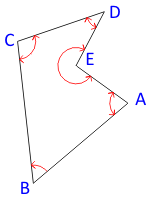2. Angular Misclosure
Angular misclosure is the difference between the measured angles' sum on a traverse and the angle condition for the traverse configuration.
The amount of allowable angular misclosure is dependent on the survey purpose. The limits are generally expressed as an Error of a Series:
 |
Equation B-4 | |
| C: Allowable misclosure, seconds k: expected error in each angle, seconds n: number of angles |
||
Traditional formal standards from the FGCS Standards and Specifications for Geodetic Control Networks are:
| Table B-1 | ||
| Angular Misclosure | ||
| Order | Class | k (sec) |
| First | - | 1.7 |
| Second | I | 3.0 |
| II | 4.5 | |
| Third | I | 10.0 |
| II | 12.0 | |
Example
What is the allowable angular misclosure for a five-sided traverse if it is to meet Second Order Class II standards, Figure B-5?
 |
| Figure B-5 Allowable Misclosure |
From Table 1, k = 4.5". Substituting into Equation B-4:

Because this is a five-sided loop traverse, using Equation B-1 the angles should sum to:

Therefore, the total should be in the range 539°59'50" to 540°00'10".
Informal standards can be created which reflect equipment, experience, conditions, project needs, etc.
Example
A control network is to be established for a construction project. Sight distances will be relatively short (under 300 ft) so measuring angles consistently will be a challenge. Testing under these conditions, our survey crew was able to measure an angle to a consistency of ±0°00'12". For this project, we will use an allowable misclosure of:
